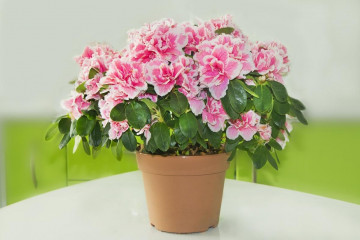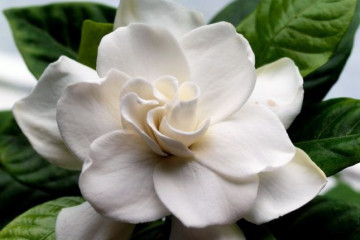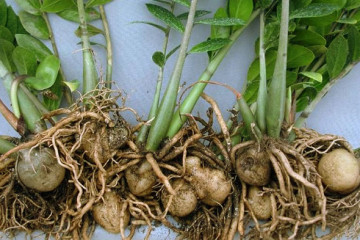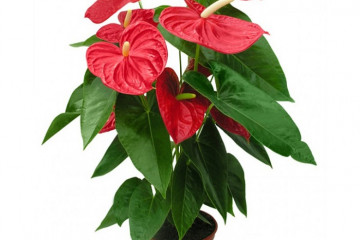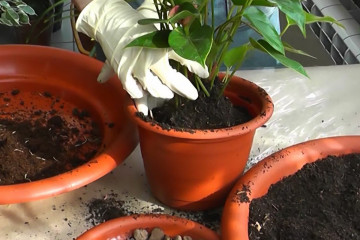Anthurium - home care after purchase
Content:
"Flamingo Flower", "Scarlet Sail", "Man's Happiness" - what names they did not give to the spectacular plant! Anthurium invariably attracts attention with its dense foliage and unusual flowering. It is believed that the peculiar energy of the flower contributes to the success of men in both business and personal life.
Anthurium - home care
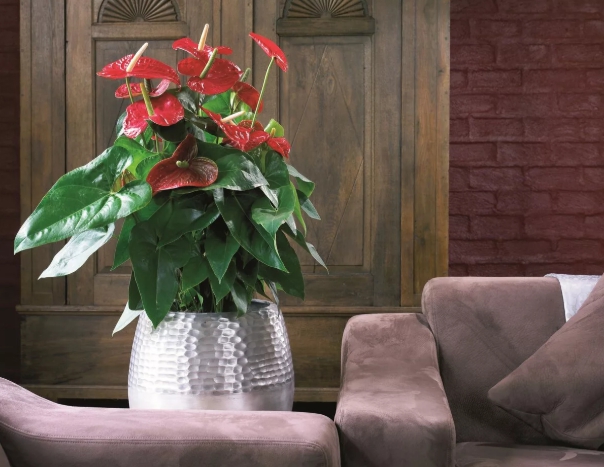
Anthurium flowers in the interior
The natural habitat of anthurium is the subtropical zones of America with a humid, warm climate. For hundreds of years, plants have adapted to these very conditions, so in order for flowers to flourish in the house, it is necessary to create a similar atmosphere for them.
Lighting and temperature
In nature, anthurium is an inhabitant of the lower tier of the tropical forest. Accordingly, in apartments, plants are shaded from bright sunlight and give them a warm place. In direct sunlight and in a draft, the leaves curl up into tubes. The east and west windows are best suited for exposure. In winter, the flower is illuminated.
For a thermophilic plant in winter, room temperature is quite suitable. Most of the cultivated species can tolerate lowering up to 10 ° C, but not crystal anthurium. This sissy with beautiful leaves needs at least 16 ° C.
During the active growing season, a comfortable temperature is 20-25 ° C.
Transplanting and feeding
A flowering plant should not be repotted immediately after purchase, even if the pot seems cramped. It is better to wait for the anthurium to bloom, otherwise it will receive additional stress.
Adults, well-developed specimens should be transplanted every 3-4 years, young plants - annually. The best time to transplant is spring.
Since in nature most anthuriums are epiphytes and are attached to trees, they need a special soil mixture. The soil for these plants should be loose, moisture-absorbing and light. You can take peat, sphagnum moss, bark, charcoal and leafy earth in equal parts. A commercially available substrate for epiphytes is also suitable.
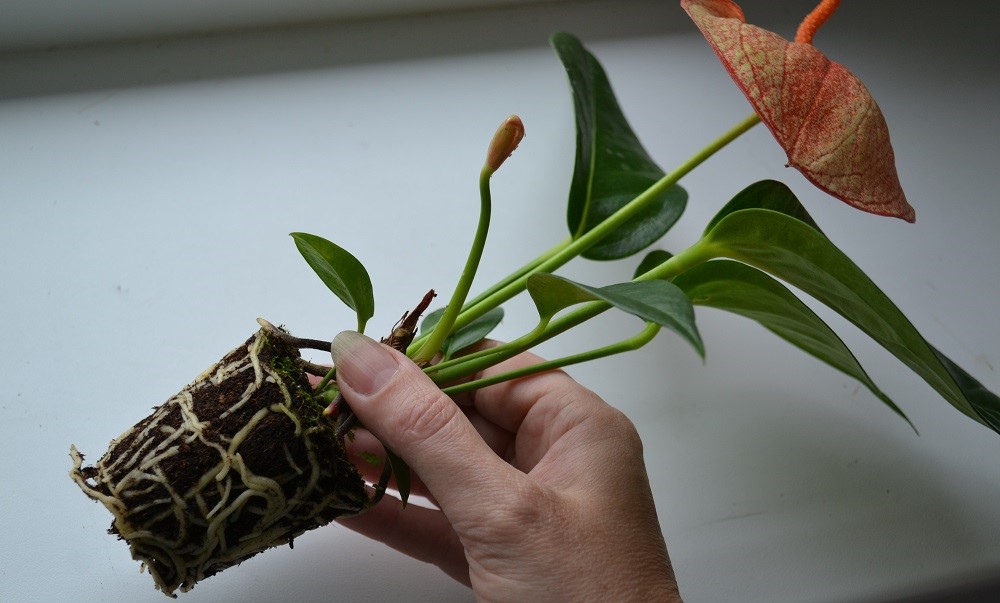
Young crops are transplanted every year
For anthuriums, wide, low pots are chosen, in which the soil dries out more evenly. Good drainage is laid at the bottom.
When transplanting, you need to carefully handle the leaves and easily breaking roots. Damaged, rotten roots are cut off. Plants are buried in the ground a little more than in the previous transplant. The soil is compacted moderately to provide air access to the roots.
Therefore, the soil for the plant should be slightly acidic, and soft water with a low salt content is suitable for irrigation. Wood ash and lime should not be added to the land mixture, these components lower the acidity.
A potted plant needs a lot of nutrients. During the flowering period, the anthurium needs to be fed with fertilizer for flowering plants; the rest of the time, the Kemira Lux complex fertilizer will do. In summer, the flower is fed every 10 days, and in winter - monthly. Moreover, mineral fertilizers alternate with organic matter. It is preferable to carry out foliar dressing, "on the sheet", in order to avoid salinization of the substrate.
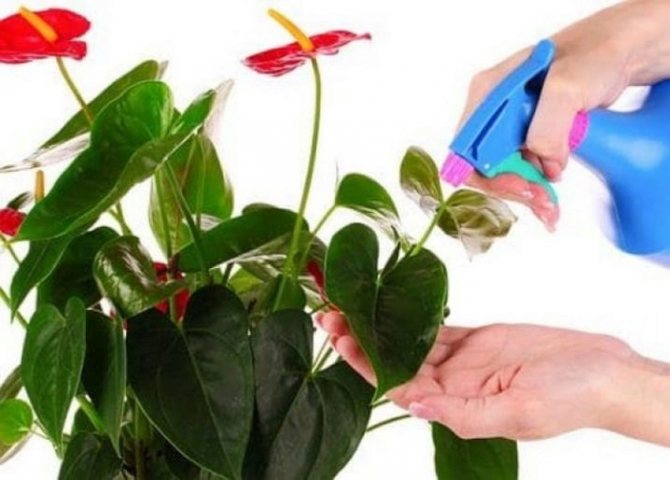
Anthurium is fed foliarly
Watering and humidity
Tropical handsome anthurium is hygrophilous.Water it abundantly, after the top layer of the earth has dried. All soil in the pot must be completely moist. Stagnation of water in the pan is unacceptable, this can lead to rotting of the roots. If water remains in the pan half an hour after watering, it must be drained.
Watering is less frequent in winter than in summer. It is better to do this with rainwater, since tap water often contains bleach. In order for the lime to settle and the chlorine to evaporate, the water is settled for 12-14 hours.
The increased air humidity is perhaps the main condition for the comfortable existence of anthurium. It is especially important to maintain it during the heating season. The plant is placed on a pallet with wet expanded clay; when the water evaporates, the humidity around the plant rises. Aerial roots that appear above the ground are wrapped in moist moss so that they do not dry out.
Anthurium loves wet procedures. Once a month, he is given a warm shower, after which he is not allowed to stand in the sun until it dries completely, so that there are no burns. You can spray the flower daily, and if the air is very dry, then in the morning and evening. It is desirable that the spray water be slightly warmer than the air in the apartment. During water procedures, you need to try so that it does not get on the flowers, otherwise dark spots may appear on them, reducing the decorative effect of the plant.
Reproduction methods
Anthurium is propagated in several ways: stem cuttings, seeds and side shoots (offspring).
Cuttings
There are 2 options for propagation by cuttings:
- The upper part of the stem, which has aerial roots, is cut with a sharp knife and the two lower leaves are removed. The stalk is placed in a container with a damp earth substrate and sprinkled with it. Cover with a transparent bag on top.
- To rejuvenate too elongated specimens, use this method. A long stem is wrapped with sphagnum moss and tied with a plastic bag on top. Moss is moistened daily. Over time, when new roots become visible, the cutting along with the roots is cut and planted in a pot, where young plants quickly adapt and grow. In this case, you can use not only the apical stalk, but also the middle part of the trunk. Young shoots grow quickly on the hemp remaining in the ground, and thus the adult plant rejuvenates.
Seed reproduction
The seeds ripen within 10-12 months after pollination. Fruits are round berries with small seeds. Germination is lost quickly, so sowing is carried out immediately after collection. The seeds are freed from the shell and do not deepen into the ground, but are placed on the surface, at a distance of 1 cm from each other. Crops are moistened and covered with foil to maintain constant humidity and temperature around 22-24 ° C.
After two weeks, the seeds will germinate. A month and a half later, in the true leaf phase, the seedlings dive. As you grow, a second pick is possible. The grown seedlings in the 4-5 leaf phase should be planted in separate pots with a diameter of 5 cm. Over time, young plants are transferred into 10-cm containers.
Further care for the anthurium flower is carried out at home, as for an adult plant. Flowering begins two years after sowing.
Reproduction by offspring
The easiest way to get a new plant is to remove the stems during transplanting. To do this, an adult, overgrown specimen is taken out of the pot, shaken off the ground and divided into parts, carefully unraveling the intertwined roots. The offspring are planted in separate pots filled with a moist substrate. The growth point must be above ground level.
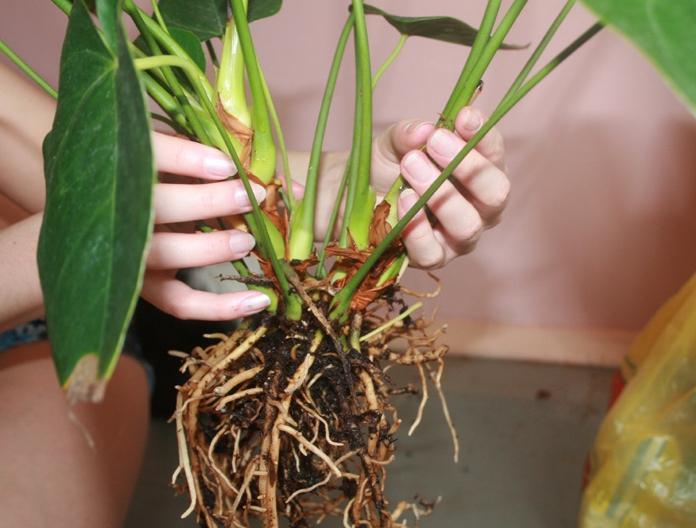
Breeding by side offspring
The planted plants are placed in a warm, bright place and often sprayed. In 2-3 weeks, the plants fully adapt to new conditions and release new leaves. No additional feeding is needed within a month after separation.
Pruning
To impart beauty and general rejuvenation of the culture, in May-June, the tops are trimmed or the lateral overgrown stems are removed. The air roots themselves do not touch.
Bloom
The culture blooms throughout the spring and summer. Blooming anthurium certainly attracts attention. A colorful, gracefully bent bract gently covers the ear, which contains small yellow or white flowers. The bract leaf is also called a bedspread, it can be oval or heart-shaped. The colors of the bedspreads are varied: from various shades of red to snow-white, yellow or pink. Bicolor specimens are unusually beautiful.

Bicolor anthurium
The bright color of the bracts attracts insects for pollination, and the cover also has a protective function. The tissues of the bract accumulate useful substances necessary for the development of the inflorescence.
Winter care, dormant period
In winter, anthurium is in a natural state of dormancy. At the same time, he does not hibernate, shedding all the leaves, but simply slows down development a little. During this period, the plant does not bloom, it is watered and fertilized less.
From the end of February, all life processes are gradually activated, in the spring there is a noticeable growth and flowering begins. Flowers bloom until autumn, and some specimens that are in comfortable conditions bloom almost all year round.
Why does not it bloom, what to do
Most often, it is the wrong temperature regime that is the answer to the question of why anthurium does not bloom. To set flower buds, an ambient temperature of 22 ° C is required. You can stretch flowering by adjusting it.
To ensure abundant flowering, adult specimens are kept from August to December at a temperature of 22 ° C during the day and 18 ° C at night. From January to March, night temperatures are lowered to 15 ° C.
When the bedspread withers, the inflorescence is removed, if you do not plan to get seeds for propagation. Ripening of fruits takes a lot of energy from the plant and after that the anthurium will not be able to bloom for a long time.
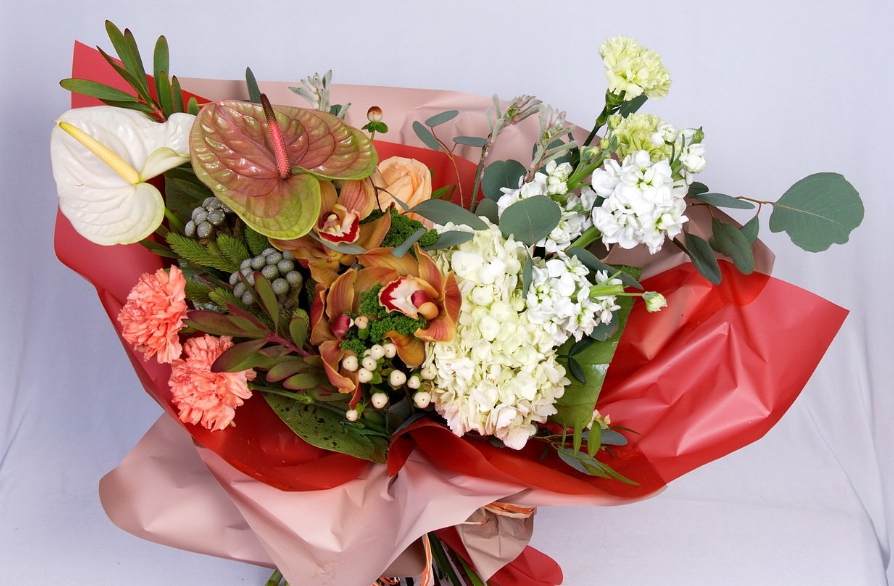
Bouquet with anthurium stays fresh for 3 weeks
Pests and diseases
Almost all types of anthurium are resistant to indoor conditions, so they are often used to decorate various interiors. However, if optimal conditions are not observed, weakened specimens can be susceptible to diseases or pest attacks. To prevent insects from multiplying, you should regularly cut off dried leaves and faded inflorescences. All plant residues are immediately thrown away.
Pests
Anthurium has dense leaves, so insects rarely attack it. The main pests that threaten the plant are:
- Shields. They are recognized by sticky secretions on the leaves, and over time, brownish wax plaques - shields become visible. With a weak lesion, a soap solution helps. If there are many pests, the bush is treated with Aktara solution.
- Aphid. It can enter the room through open windows or it can be brought in with a bouquet of cut flowers. In any case, a pest may well take a fancy to a houseplant. Fitoverm will help to get rid of aphids.
- Mealybug. It is clearly visible on the leaves of anthurium. Scorm is a small insect covered with white cotton-like secretions. Pest females suck sap from the leaves, damaging the leaf plate. If a mealybug is found, the plant is treated twice with "Fufanon", with a week break between treatments.
Diseases
Anthurium suffers from diseases more often than from pests.Diseases are caused by pathogenic fungi and high humidity. The ability to resist disease will depend on how you care for the anthurium. In good conditions, the plant has strong immunity and is able to resist ailments.
Septoria (white spot) appears as irregular gray or brownish spots with a yellow border. Usually the disease occurs on plants suffering from lack of light and nitrogen deficiency. The disease progresses with high temperature and humidity. The damaged parts are removed, and the plant is treated with the "Abiga-peak" preparation. Since the spores of the fungus can also be in the soil, it is also processed.

Septoria on the leaves of anthurium
Root decay is the most common anthurium problem. This disease is associated with improper watering. In this case, the leaves turn yellow and wither. A diseased plant is taken out of the ground, the root system is examined and rotten areas are removed. The slices are sprinkled with crushed charcoal and left for a couple of hours in the open air. When the slices are dry, the flower is planted in a new substrate. Spray the leaves with Epin and cover the plant with a transparent bag.
With proper care, anthurium grows healthy and can bloom almost all the time. This valuable decorative leafy and at the same time beautifully flowering species is often used for group compositions in the interior of the premises and in winter gardens. The variety of colors allows you to make bright flower arrangements and delicate bouquets. The plant is popular with amateur flower growers and professional designers.
